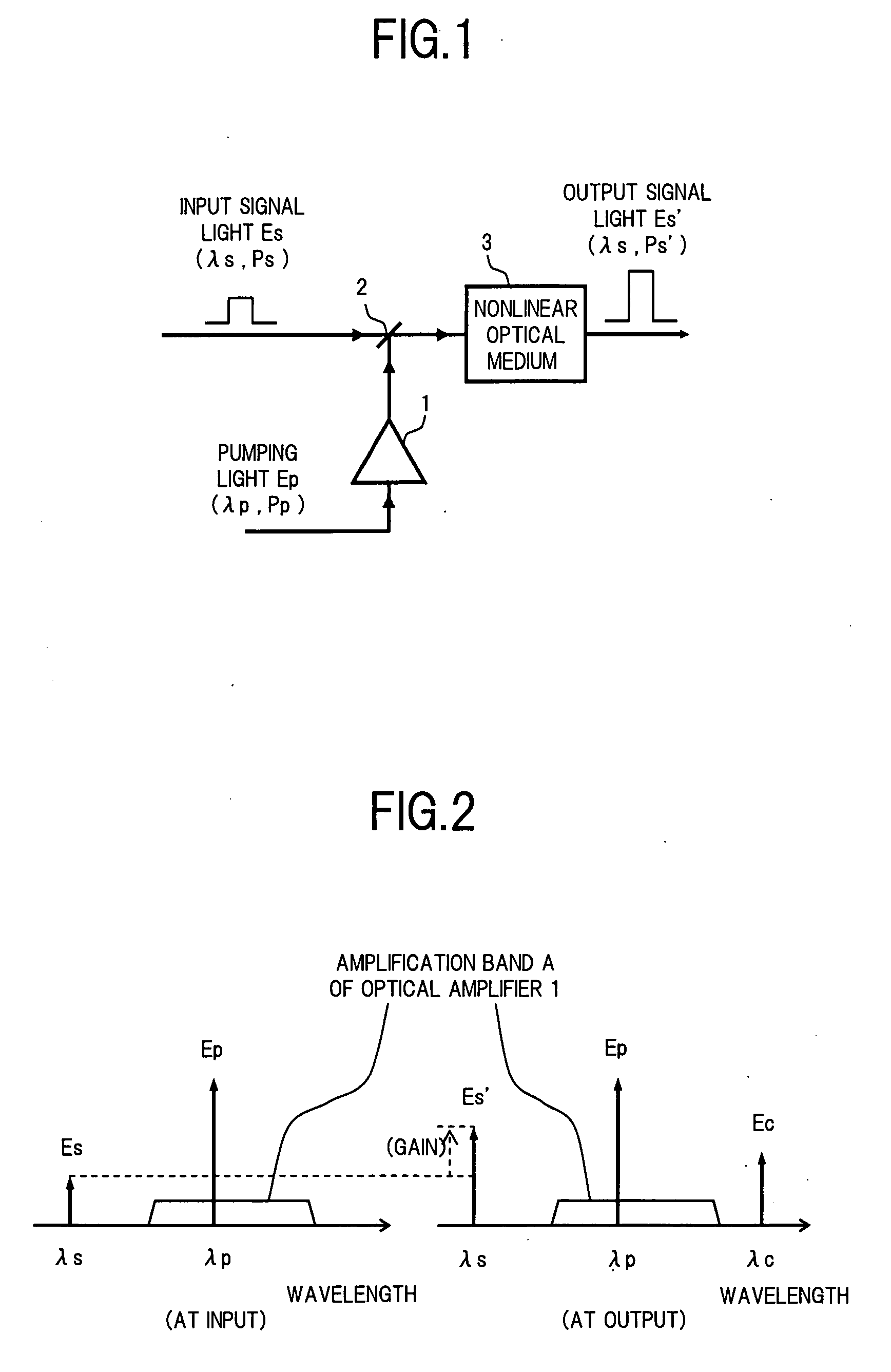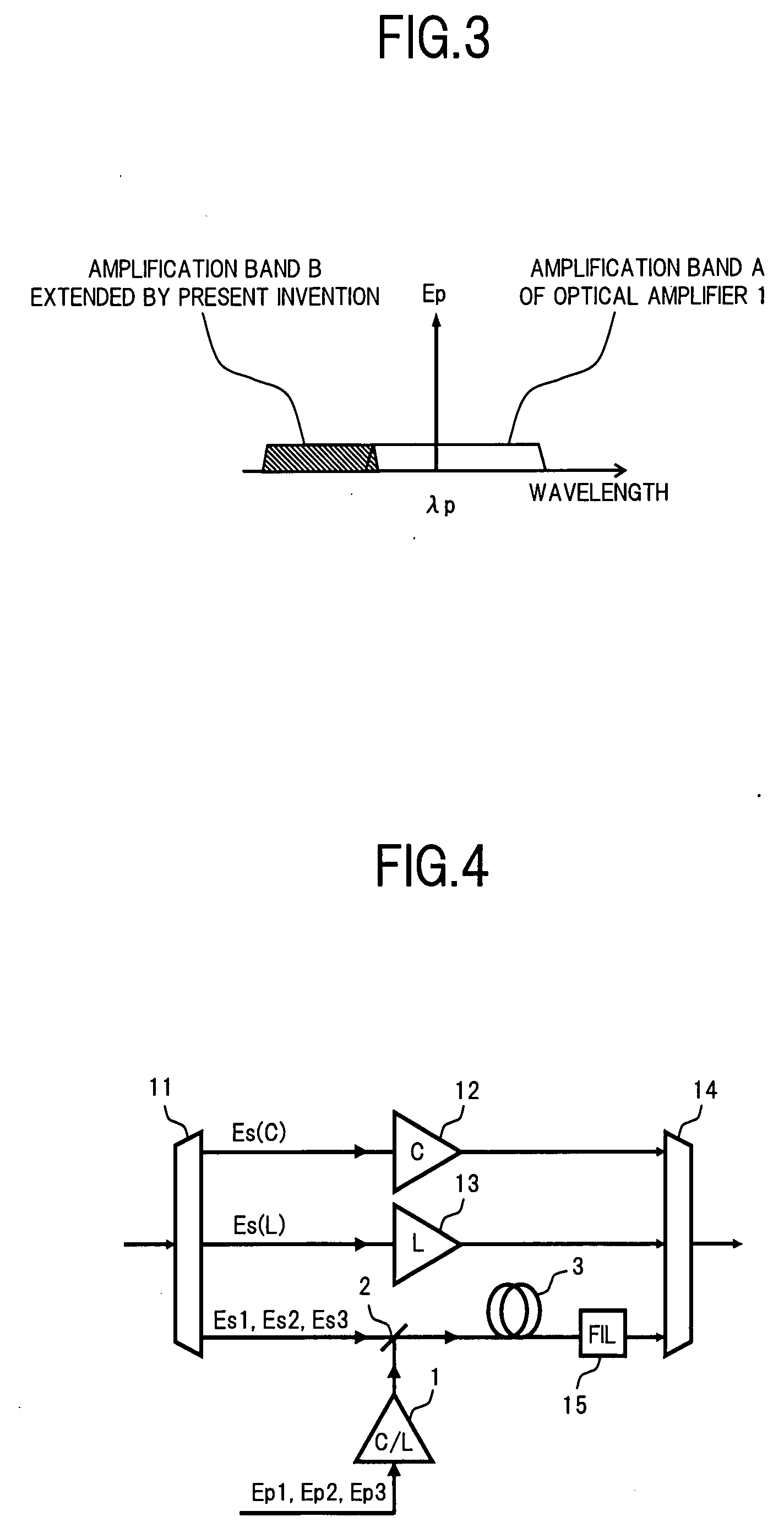Optical parametric amplifier
an optical parametric amplifier and amplifier technology, applied in optics, instruments, electromagnetic transmission, etc., can solve the problems of limiting the amplification band of the actual optical fiber amplifier, the influence of the reduction of the optical s/n ratio due to the addition of amplified spontaneous emission (ase) is severe, and the effect of reducing the noise of the ase is small, extending the amplification band, and favorable noise characteristics
- Summary
- Abstract
- Description
- Claims
- Application Information
AI Technical Summary
Benefits of technology
Problems solved by technology
Method used
Image
Examples
first embodiment
[0045]FIG. 4 is a diagram showing a configuration of an optical parametric amplifier according to the present invention.
[0046]In FIG. 4, the optical parametric amplifier of this embodiment uses the basic configuration as shown before in FIG. 1, and is configured so as to extend the amplification band of the conventional EDFA corresponding to the C- and L-bands. More specifically, in the present optical parametric amplifier, the input WDM signal light is applied to a branching filter 11, and is branched into a signal light Es (C) of C-band, a signal light Es (L) of L-band, and signal lights Es1, Es2 and Es3 outside of the C- and L-bands. To the output port corresponding to the C-band of the branching filter 11 is connected the input port of the C-band EDFA 12. Furthermore, to the output port corresponding to the L-band of the branching filter 11 is connected the input port of the L-band EDFA 13. Moreover, to the output port corresponding to other than the C- and L-bands is connected ...
second embodiment
[0053]Next is a description of the present invention.
[0054]FIG. 6 is a diagram showing a configuration of the second embodiment of an optical parametric amplifier according to the present invention.
[0055]In FIG. 6, the optical parametric amplifier of this embodiment is one which uses the basic configuration shown before in FIG. 1, to increase the gain with respect to the signal light of a specific wavelength in the conventional optical amplifier. More specifically, in this optical parametric amplifier, the input signal light Es is applied to a conventional optical amplifier 16 such as an EDFA. This optical amplifier 16 is basically the same as the optical amplifier 1 to which the pumping light Ep is input. Here the wavelength λs of the signal light Es is set to a wavelength which is different to the wavelength λp of the pumping light Ep in the amplification band of the optical amplifier 16. The signal light Es amplified by the optical amplifier 16 is applied to the signal light inpu...
third embodiment
[0058]Next is a description of the present invention.
[0059]FIG. 8 is a diagram showing a configuration of the third embodiment of an optical parametric amplifier according to the present invention.
[0060]In FIG. 8, the optical parametric amplifier of this embodiment is an application example for where in the basic configuration shown before in FIG. 1, control of the polarization and power of the signal light and the pumping light is performed so as to produce the nonlinear optical effect at an optimum state.
[0061]More specifically, in this optical parametric amplifier, a polarization controller 21 for controlling the polarization of the input signal light Es, is connected to the signal light input port of a multiplexer 2. Furthermore, a polarization controller 22 for controlling the polarization of the pumping light Ep, is connected to the input port of an optical amplifier 1. Moreover, a power controller 23 (for example a variable optical attenuator or the like) for controlling the ...
PUM
 Login to View More
Login to View More Abstract
Description
Claims
Application Information
 Login to View More
Login to View More - R&D
- Intellectual Property
- Life Sciences
- Materials
- Tech Scout
- Unparalleled Data Quality
- Higher Quality Content
- 60% Fewer Hallucinations
Browse by: Latest US Patents, China's latest patents, Technical Efficacy Thesaurus, Application Domain, Technology Topic, Popular Technical Reports.
© 2025 PatSnap. All rights reserved.Legal|Privacy policy|Modern Slavery Act Transparency Statement|Sitemap|About US| Contact US: help@patsnap.com



